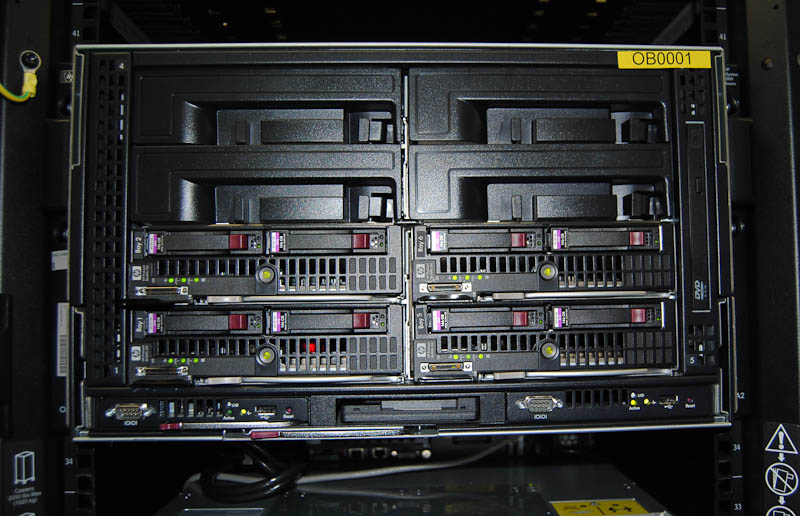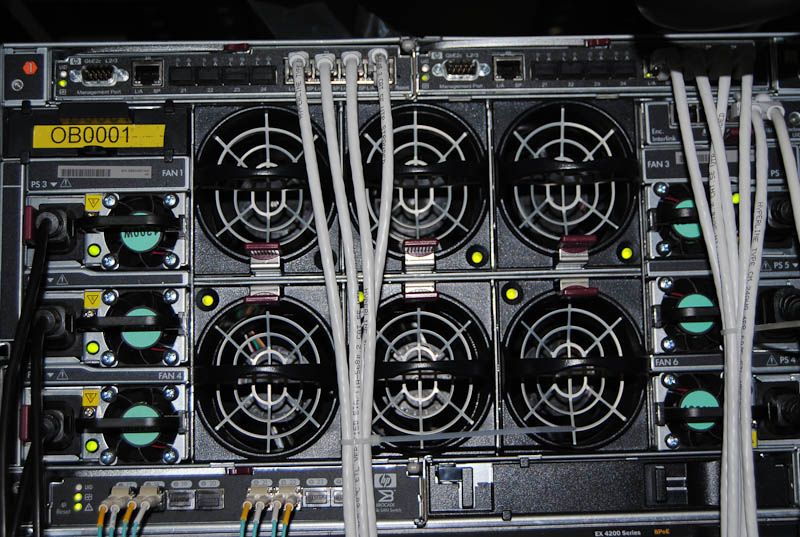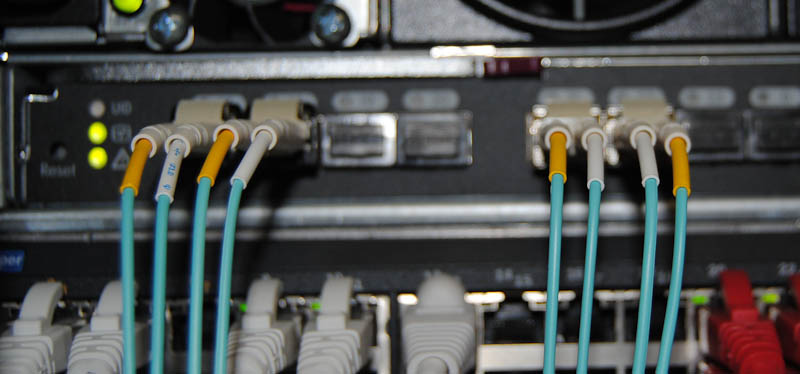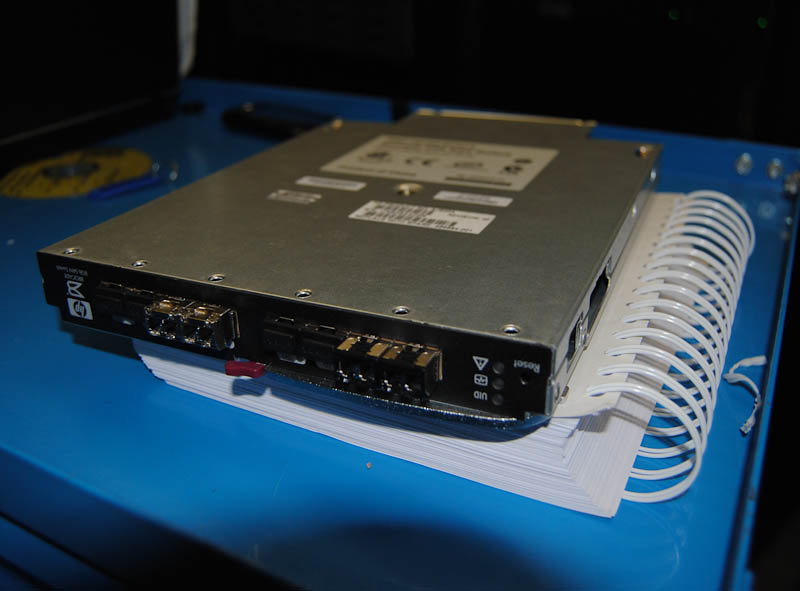The architecture of the hardware complex Cloud One
In the process of negotiating with clients, we often have to talk in detail about the architecture and the individual elements of our hardware complex, about what hardware and what software our services work with. Most often this happens when discussing the price or parameters of a hosted project, especially if our potential clients monitor the market and compare offers. Now in our blog will be this post, able to dot the “i”. And, of course, we hope that it will be of interest to all Habram people associated with data storage technologies, server technologies and cloud services.

')
We chose the HP BladeSystem c3000 blade-server baskets as the basis for the complex, as providing an optimal price-performance ratio and having good opportunities for expansion. The HP BL460c G6 servers on Xeon 5650 processors are installed in the recycle bin. The maximum amount of memory for a virtual machine can reach 95 GB, and the blade server - 192 GB, which is also very important in the light of the lease of virtual machines.

Each of the servers has “onboard” two built-in Ethernet ports and two additional ones implemented using the Intel NC360m Dual Port mezzanine card as SAN (iSCSI) ports for backup procedures.

The very same storage network is built on Netapp FAS3240 data storage systems. The high-speed data interface is an 8-gigabit FibreChannel. Brocade 804 FC cards are installed in each of the blade servers, Brocade Blade Switch 8/12 FC switches are responsible for switching, and all together it forms a fault-tolerant HA cluster.




The IP network is organized using a stack of Juniper EX4200 switches. To increase fault tolerance, switches are duplicated.
One of the features of our virtual machines is the VMware vSphere 4.1 virtualization environment with the ESXi hypervisor. This leaves its serious imprint on the parameters of work and the cost of resources. The HA / DRS cluster was assembled from the hypervisor hosts (BL460c G6), which allows to drastically reduce the recovery time in the event of a physical infrastructure failure. To distribute the load on the host system is used DRS. Thanks to vSphere, virtual machines support almost any operating system, with the exception of “desktop” Mac OS X and very exotic options.
On the client side, too, a lot of interesting things. First of all, this is a round-the-clock access to the virtual machine management console, where you can perform basic management functions. We do not provide the ability to independently regulate the amount of allocated resources to customers, but a change in the power of the virtual machine is made promptly, upon request to the round-the-clock technical support service. In the overwhelming majority of operating systems, the change in the amount of available processor power, RAM, and disk space is done without rebooting. Available options include backup (virtual backup) of virtual machines, taking snapshots of the file system, organizing NFS volumes directly on the storage system (NetApp FAS3240 can act as a multi-protocol SAN / NAS storage).

We hope that the data provided in this post can partly justify our tariff policy and serve as a starting point for subsequent materials. In the meantime, taking this opportunity, we inform about the next reduction of our tariffs for virtual machines. Now they all include a VMware Standard license. You can get acquainted with the tariffs here: www.cloudone.ru/direction/virtual-server

')
We chose the HP BladeSystem c3000 blade-server baskets as the basis for the complex, as providing an optimal price-performance ratio and having good opportunities for expansion. The HP BL460c G6 servers on Xeon 5650 processors are installed in the recycle bin. The maximum amount of memory for a virtual machine can reach 95 GB, and the blade server - 192 GB, which is also very important in the light of the lease of virtual machines.

Each of the servers has “onboard” two built-in Ethernet ports and two additional ones implemented using the Intel NC360m Dual Port mezzanine card as SAN (iSCSI) ports for backup procedures.

The very same storage network is built on Netapp FAS3240 data storage systems. The high-speed data interface is an 8-gigabit FibreChannel. Brocade 804 FC cards are installed in each of the blade servers, Brocade Blade Switch 8/12 FC switches are responsible for switching, and all together it forms a fault-tolerant HA cluster.




The IP network is organized using a stack of Juniper EX4200 switches. To increase fault tolerance, switches are duplicated.
One of the features of our virtual machines is the VMware vSphere 4.1 virtualization environment with the ESXi hypervisor. This leaves its serious imprint on the parameters of work and the cost of resources. The HA / DRS cluster was assembled from the hypervisor hosts (BL460c G6), which allows to drastically reduce the recovery time in the event of a physical infrastructure failure. To distribute the load on the host system is used DRS. Thanks to vSphere, virtual machines support almost any operating system, with the exception of “desktop” Mac OS X and very exotic options.
On the client side, too, a lot of interesting things. First of all, this is a round-the-clock access to the virtual machine management console, where you can perform basic management functions. We do not provide the ability to independently regulate the amount of allocated resources to customers, but a change in the power of the virtual machine is made promptly, upon request to the round-the-clock technical support service. In the overwhelming majority of operating systems, the change in the amount of available processor power, RAM, and disk space is done without rebooting. Available options include backup (virtual backup) of virtual machines, taking snapshots of the file system, organizing NFS volumes directly on the storage system (NetApp FAS3240 can act as a multi-protocol SAN / NAS storage).

We hope that the data provided in this post can partly justify our tariff policy and serve as a starting point for subsequent materials. In the meantime, taking this opportunity, we inform about the next reduction of our tariffs for virtual machines. Now they all include a VMware Standard license. You can get acquainted with the tariffs here: www.cloudone.ru/direction/virtual-server
Source: https://habr.com/ru/post/117481/
All Articles